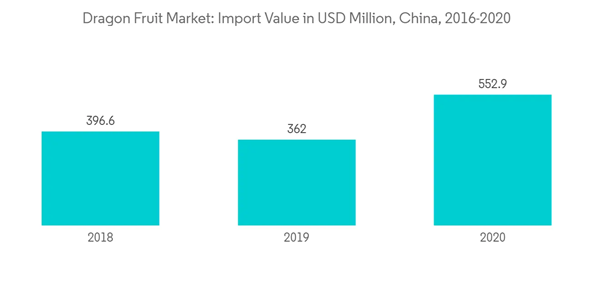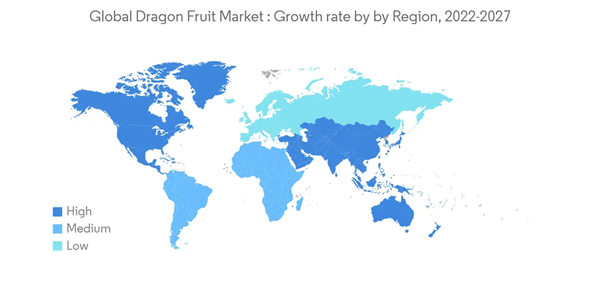The Dragon Fruit Market size is estimated at USD 14.73 billion in 2024, and is expected to reach USD 18.27 billion by 2029, growing at a CAGR of 4.40% during the forecast period (2024-2029).
In addition to the serious implications on people's health and healthcare services, the COVID-19 pandemic has had a significant impact on the global dragon fruit market as well. In terms of demand, low demand was observed in supermarkets where consumers are mostly focused on healthy products with a long shelf life, and hence, demand for fruits remained low in many Asian countries, such as China. Further, as the restaurants were closed during the COVID-19 pandemic, the market demand for dragon fruit suddenly dropped. Intermediaries were afraid of unmarketable conditions, so they reduced their purchase volume in production areas. This widened the demand supply gap in many countries.
The dragon fruit market is growing at a robust rate, owing to the increasing demand for fresh dragon fruit. Additionally, the demand for exotic tropical fruit is on the rise in recent years due to various health benefits that they offer and an overall increase in disposable income of the consumers, especially in developing nations. In Europe, although the dragon fruit is relatively new and is not widely advertised, still the market is very promising and attracting more and more consumers. These are the major factors that are driving the market growth of dragon fruits.
Health-conscious consumers are increasingly demanding dragon fruit, especially in the United States. Dragon fruit is available in the United States year-round, however, is also imported from a few different countries. As the dragon fruit is considered a specialty product, the MRL (Maximum Residue Level) laws for dragon fruit in the United States are very different compared to traditional products like apples or cherries. Only about 13 chemicals can be used on the fruit to supply to the United States.
Asia-Pacific dominates the dragon fruit market both in terms of production as well as consumption. Dragon fruit is one of the prominent export fruit of Vietnam. The international trade in dragon fruit mainly revolves around major exporters like countries in South East Asia and Central America which represents the maximum share of the entire international trade of dragon fruits.
The Chinese people consume most of the whole dragon fruit produced from Vietnam. According to the Ministry of Industry and Trade of Vietnam, 80.0% of the dragon fruits produced in Vietnam are exported to China, while 99.0% of dragon fruits in the Chinese market are imported from Vietnam. The demand for the Vietnamese dragon fruit is high in the Chinese market mainly due to its sizable production and high economic importance.
In May 2020, China's General Administration of Customs permitted several varieties of fresh dragon fruit from Indonesia. The dragon fruit varieties that are allowed for import include purple-fleshed dragon fruit, red-fleshed dragon fruit and white-fleshed dragon fruit. This is one of the factors that is driving the market for dragon fruit in China.
In Asia, Vietnam is a leading supplier to the Chinese market, but other markets such as ASEAN and Hong Kong have been increasingly competitive from countries such as Taiwan, Thailand, and Malaysia. Additionally, Asia is not only leading the production but also as the largest dragon fruit-consuming market, especially among the Chinese community. China is the largest consumer of dragon fruit in Asia and is also the largest in the world today.
Recently, Vietnam signed a free trade agreement with the European Union, known as the European Union-Vietnam Free Trade Agreement (EVFTA). This agreement allowed Vietnamese imports to almost trade tariff-free and enabled them to control red skin red pulp dragon fruit import prices in the region. Hence, the exports of red skin red pulp dragon fruits from Vietnam to the European Union is anticipated to grow at a faster rate during the forecast period.
This product will be delivered within 2 business days.
In addition to the serious implications on people's health and healthcare services, the COVID-19 pandemic has had a significant impact on the global dragon fruit market as well. In terms of demand, low demand was observed in supermarkets where consumers are mostly focused on healthy products with a long shelf life, and hence, demand for fruits remained low in many Asian countries, such as China. Further, as the restaurants were closed during the COVID-19 pandemic, the market demand for dragon fruit suddenly dropped. Intermediaries were afraid of unmarketable conditions, so they reduced their purchase volume in production areas. This widened the demand supply gap in many countries.
The dragon fruit market is growing at a robust rate, owing to the increasing demand for fresh dragon fruit. Additionally, the demand for exotic tropical fruit is on the rise in recent years due to various health benefits that they offer and an overall increase in disposable income of the consumers, especially in developing nations. In Europe, although the dragon fruit is relatively new and is not widely advertised, still the market is very promising and attracting more and more consumers. These are the major factors that are driving the market growth of dragon fruits.
Health-conscious consumers are increasingly demanding dragon fruit, especially in the United States. Dragon fruit is available in the United States year-round, however, is also imported from a few different countries. As the dragon fruit is considered a specialty product, the MRL (Maximum Residue Level) laws for dragon fruit in the United States are very different compared to traditional products like apples or cherries. Only about 13 chemicals can be used on the fruit to supply to the United States.
Asia-Pacific dominates the dragon fruit market both in terms of production as well as consumption. Dragon fruit is one of the prominent export fruit of Vietnam. The international trade in dragon fruit mainly revolves around major exporters like countries in South East Asia and Central America which represents the maximum share of the entire international trade of dragon fruits.
Dragon Fruit Market Trends
Growing Demand for Dragon Fruit in China
Dragon fruit has high water content and is a good source of iron, magnesium, vitamin B, phosphorus, protein, calcium, and fiber. The fruit's edible seeds are also nutritious and have been proved to lower the risk of cardiovascular disorders. Dragon fruit is a low-calorie fruit that is high in fiber and contains a good amount of vitamins and minerals. Owing to the aforementioned benefits, coupled with the changing diet pattern among the Chinese population, the demand for dragon fruit is increasing, thereby, escalating the imports.The Chinese people consume most of the whole dragon fruit produced from Vietnam. According to the Ministry of Industry and Trade of Vietnam, 80.0% of the dragon fruits produced in Vietnam are exported to China, while 99.0% of dragon fruits in the Chinese market are imported from Vietnam. The demand for the Vietnamese dragon fruit is high in the Chinese market mainly due to its sizable production and high economic importance.
In May 2020, China's General Administration of Customs permitted several varieties of fresh dragon fruit from Indonesia. The dragon fruit varieties that are allowed for import include purple-fleshed dragon fruit, red-fleshed dragon fruit and white-fleshed dragon fruit. This is one of the factors that is driving the market for dragon fruit in China.
Asia-Pacific Dominates the Market
In the Asia Pacific, Vietnam, China and Indonesia are the largest producers of dragon fruit. Vietnam alone contributed more than 50.0% to global dragon fruit production and the majority of the fruit production is meant for exports rather than domestic consumption. It is categorized as a high-value crop, and the local fruit industry in Vietnam has a competitive advantage. In Vietnam, the total area under the production of dragon fruit is approximately 55,000.0 hectares in 2019 with the white flesh variety accounting for more than 95.0% of production, followed by the red flesh variety at 4.5%. Dragon fruit is mainly grown in Binh Thuan, Long An, and Tien Giang provinces with more than 48,000.0 ha being devoted to its production, annually. However, recently dragon fruit production in Vietnam is facing many difficulties, including the impact of climate change and disease emergence.In Asia, Vietnam is a leading supplier to the Chinese market, but other markets such as ASEAN and Hong Kong have been increasingly competitive from countries such as Taiwan, Thailand, and Malaysia. Additionally, Asia is not only leading the production but also as the largest dragon fruit-consuming market, especially among the Chinese community. China is the largest consumer of dragon fruit in Asia and is also the largest in the world today.
Recently, Vietnam signed a free trade agreement with the European Union, known as the European Union-Vietnam Free Trade Agreement (EVFTA). This agreement allowed Vietnamese imports to almost trade tariff-free and enabled them to control red skin red pulp dragon fruit import prices in the region. Hence, the exports of red skin red pulp dragon fruits from Vietnam to the European Union is anticipated to grow at a faster rate during the forecast period.
Dragon Fruit Industry Overview
Additional Benefits:
- The market estimate (ME) sheet in Excel format
- 3 months of analyst support
This product will be delivered within 2 business days.
Table of Contents
1 INTRODUCTION
4 MARKET DYNAMICS
5 MARKET SEGMENTATION










